jump start SKODA CITIGO 2014 1.G Owner's Manual
[x] Cancel search | Manufacturer: SKODA, Model Year: 2014, Model line: CITIGO, Model: SKODA CITIGO 2014 1.GPages: 164, PDF Size: 12.08 MB
Page 5 of 164
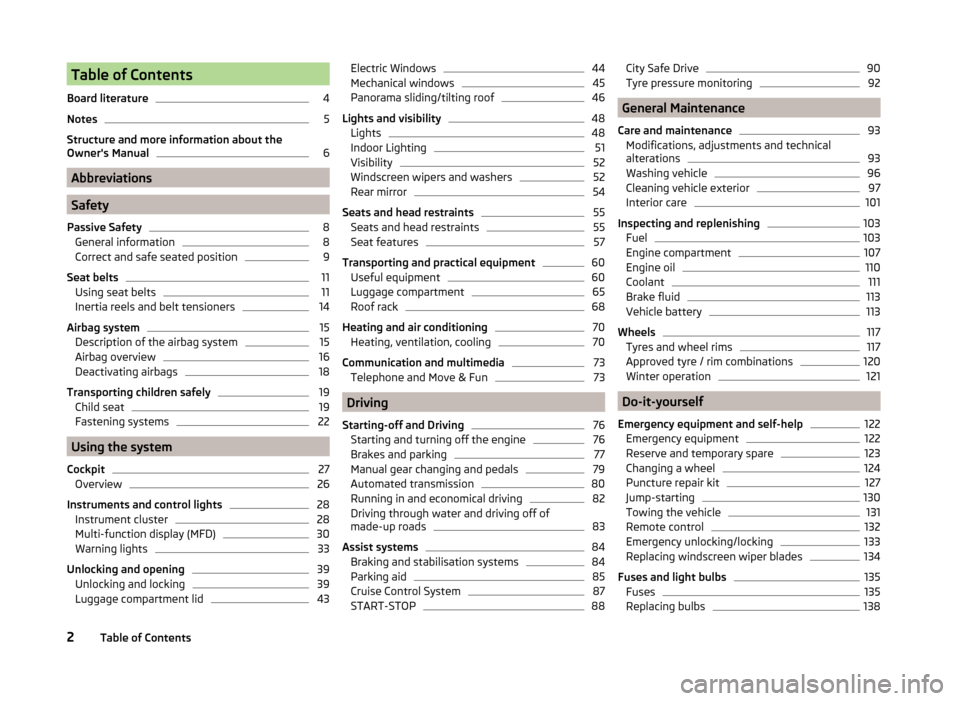
Table of Contents
Board literature4
Notes
5
Structure and more information about the
Owner's Manual
6
Abbreviations
Safety
Passive Safety
8
General information
8
Correct and safe seated position
9
Seat belts
11
Using seat belts
11
Inertia reels and belt tensioners
14
Airbag system
15
Description of the airbag system
15
Airbag overview
16
Deactivating airbags
18
Transporting children safely
19
Child seat
19
Fastening systems
22
Using the system
Cockpit
27
Overview
26
Instruments and control lights
28
Instrument cluster
28
Multi-function display (MFD)
30
Warning lights
33
Unlocking and opening
39
Unlocking and locking
39
Luggage compartment lid
43Electric Windows44Mechanical windows45
Panorama sliding/tilting roof
46
Lights and visibility
48
Lights
48
Indoor Lighting
51
Visibility
52
Windscreen wipers and washers
52
Rear mirror
54
Seats and head restraints
55
Seats and head restraints
55
Seat features
57
Transporting and practical equipment
60
Useful equipment
60
Luggage compartment
65
Roof rack
68
Heating and air conditioning
70
Heating, ventilation, cooling
70
Communication and multimedia
73
Telephone and Move & Fun
73
Driving
Starting-off and Driving
76
Starting and turning off the engine
76
Brakes and parking
77
Manual gear changing and pedals
79
Automated transmission
80
Running in and economical driving
82
Driving through water and driving off of
made-up roads
83
Assist systems
84
Braking and stabilisation systems
84
Parking aid
85
Cruise Control System
87
START-STOP
88City Safe Drive90Tyre pressure monitoring92
General Maintenance
Care and maintenance
93
Modifications, adjustments and technical alterations
93
Washing vehicle
96
Cleaning vehicle exterior
97
Interior care
101
Inspecting and replenishing
103
Fuel
103
Engine compartment
107
Engine oil
110
Coolant
111
Brake fluid
113
Vehicle battery
113
Wheels
117
Tyres and wheel rims
117
Approved tyre / rim combinations
120
Winter operation
121
Do-it-yourself
Emergency equipment and self-help
122
Emergency equipment
122
Reserve and temporary spare
123
Changing a wheel
124
Puncture repair kit
127
Jump-starting
130
Towing the vehicle
131
Remote control
132
Emergency unlocking/locking
133
Replacing windscreen wiper blades
134
Fuses and light bulbs
135
Fuses
135
Replacing bulbs
1382Table of Contents
Page 79 of 164
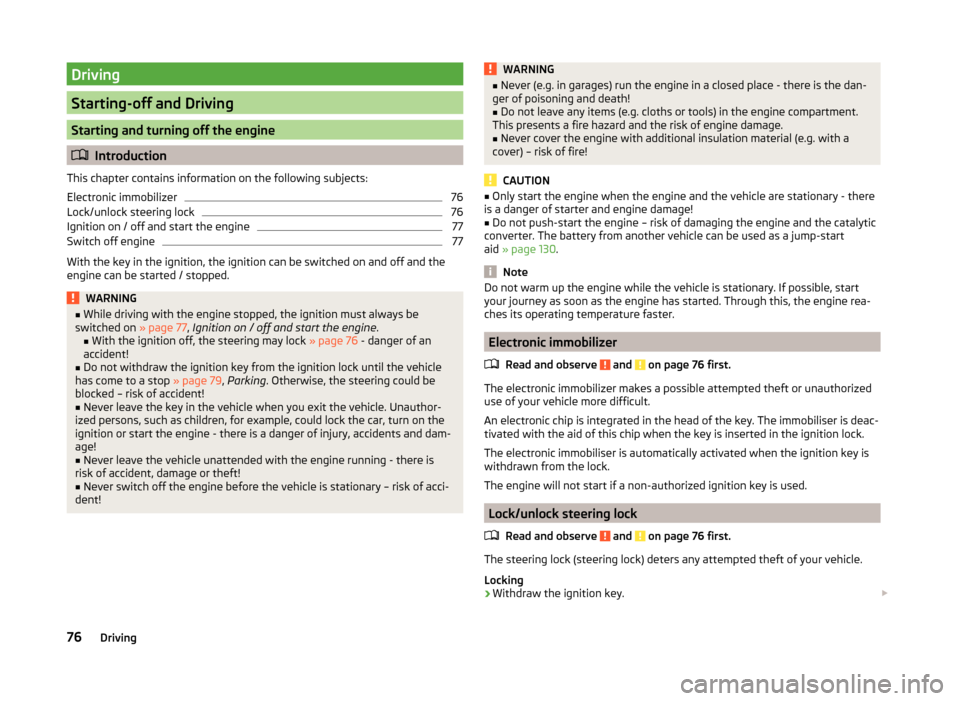
Driving
Starting-off and Driving
Starting and turning off the engine
Introduction
This chapter contains information on the following subjects:
Electronic immobilizer
76
Lock/unlock steering lock
76
Ignition on / off and start the engine
77
Switch off engine
77
With the key in the ignition, the ignition can be switched on and off and the
engine can be started / stopped.
WARNING■ While driving with the engine stopped, the ignition must always be
switched on » page 77, Ignition on / off and start the engine .
■ With the ignition off, the steering may lock » page 76 - danger of an
accident!■
Do not withdraw the ignition key from the ignition lock until the vehicle
has come to a stop » page 79, Parking . Otherwise, the steering could be
blocked – risk of accident!
■
Never leave the key in the vehicle when you exit the vehicle. Unauthor-
ized persons, such as children, for example, could lock the car, turn on the
ignition or start the engine - there is a danger of injury, accidents and dam-
age!
■
Never leave the vehicle unattended with the engine running - there is
risk of accident, damage or theft!
■
Never switch off the engine before the vehicle is stationary – risk of acci-
dent!
WARNING■ Never (e.g. in garages) run the engine in a closed place - there is the dan-
ger of poisoning and death!■
Do not leave any items (e.g. cloths or tools) in the engine compartment.
This presents a fire hazard and the risk of engine damage.
■
Never cover the engine with additional insulation material (e.g. with a
cover) – risk of fire!
CAUTION
■ Only start the engine when the engine and the vehicle are stationary - there
is a danger of starter and engine damage!■
Do not push-start the engine – risk of damaging the engine and the catalytic
converter. The battery from another vehicle can be used as a jump-start
aid » page 130 .
Note
Do not warm up the engine while the vehicle is stationary. If possible, start
your journey as soon as the engine has started. Through this, the engine rea-
ches its operating temperature faster.
Electronic immobilizer
Read and observe
and on page 76 first.
The electronic immobilizer makes a possible attempted theft or unauthorizeduse of your vehicle more difficult.
An electronic chip is integrated in the head of the key. The immobiliser is deac-
tivated with the aid of this chip when the key is inserted in the ignition lock.
The electronic immobiliser is automatically activated when the ignition key is
withdrawn from the lock.
The engine will not start if a non-authorized ignition key is used.
Lock/unlock steering lock
Read and observe
and on page 76 first.
The steering lock (steering lock) deters any attempted theft of your vehicle.
Locking
›
Withdraw the ignition key.
76Driving
Page 117 of 164
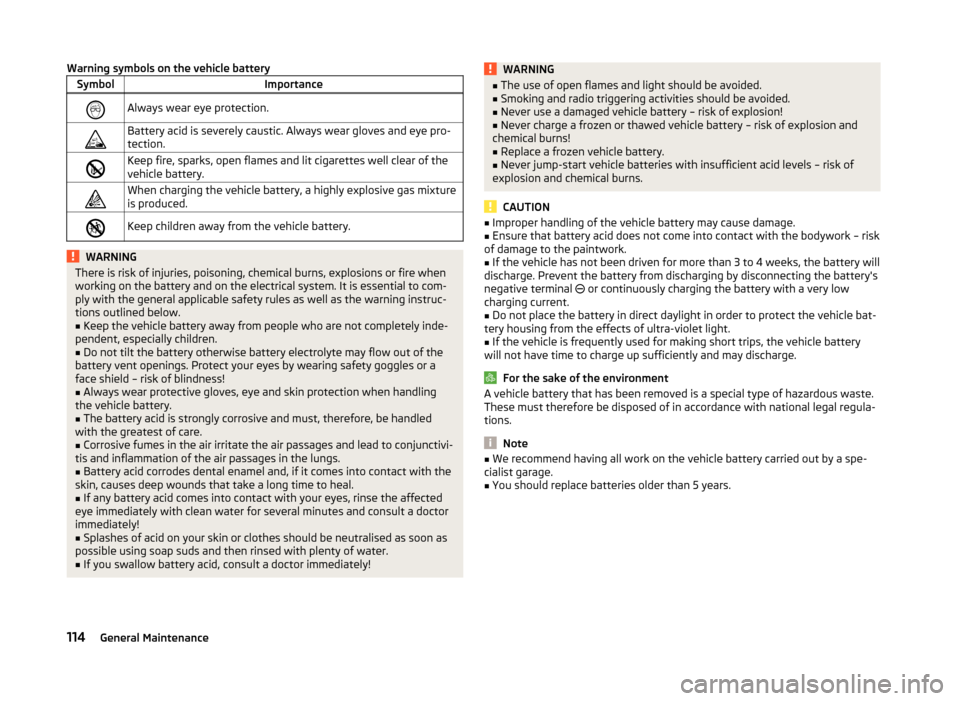
Warning symbols on the vehicle batterySymbolImportanceAlways wear eye protection.Battery acid is severely caustic. Always wear gloves and eye pro-
tection.Keep fire, sparks, open flames and lit cigarettes well clear of the
vehicle battery.When charging the vehicle battery, a highly explosive gas mixture
is produced.Keep children away from the vehicle battery.WARNINGThere is risk of injuries, poisoning, chemical burns, explosions or fire when
working on the battery and on the electrical system. It is essential to com-
ply with the general applicable safety rules as well as the warning instruc-
tions outlined below.■
Keep the vehicle battery away from people who are not completely inde-
pendent, especially children.
■
Do not tilt the battery otherwise battery electrolyte may flow out of the
battery vent openings. Protect your eyes by wearing safety goggles or a
face shield – risk of blindness!
■
Always wear protective gloves, eye and skin protection when handling
the vehicle battery.
■
The battery acid is strongly corrosive and must, therefore, be handled
with the greatest of care.
■
Corrosive fumes in the air irritate the air passages and lead to conjunctivi-
tis and inflammation of the air passages in the lungs.
■
Battery acid corrodes dental enamel and, if it comes into contact with the
skin, causes deep wounds that take a long time to heal.
■
If any battery acid comes into contact with your eyes, rinse the affected
eye immediately with clean water for several minutes and consult a doctor
immediately!
■
Splashes of acid on your skin or clothes should be neutralised as soon as
possible using soap suds and then rinsed with plenty of water.
■
If you swallow battery acid, consult a doctor immediately!
WARNING■ The use of open flames and light should be avoided.■Smoking and radio triggering activities should be avoided.■
Never use a damaged vehicle battery – risk of explosion!
■
Never charge a frozen or thawed vehicle battery – risk of explosion and
chemical burns!
■
Replace a frozen vehicle battery.
■
Never jump-start vehicle batteries with insufficient acid levels – risk of
explosion and chemical burns.
CAUTION
■ Improper handling of the vehicle battery may cause damage.■Ensure that battery acid does not come into contact with the bodywork – risk
of damage to the paintwork.■
If the vehicle has not been driven for more than 3 to 4 weeks, the battery will
discharge. Prevent the battery from discharging by disconnecting the battery's
negative terminal
or continuously charging the battery with a very low
charging current.
■
Do not place the battery in direct daylight in order to protect the vehicle bat-
tery housing from the effects of ultra-violet light.
■
If the vehicle is frequently used for making short trips, the vehicle battery
will not have time to charge up sufficiently and may discharge.
For the sake of the environment
A vehicle battery that has been removed is a special type of hazardous waste.
These must therefore be disposed of in accordance with national legal regula-
tions.
Note
■ We recommend having all work on the vehicle battery carried out by a spe-
cialist garage.■
You should replace batteries older than 5 years.
114General Maintenance
Page 133 of 164
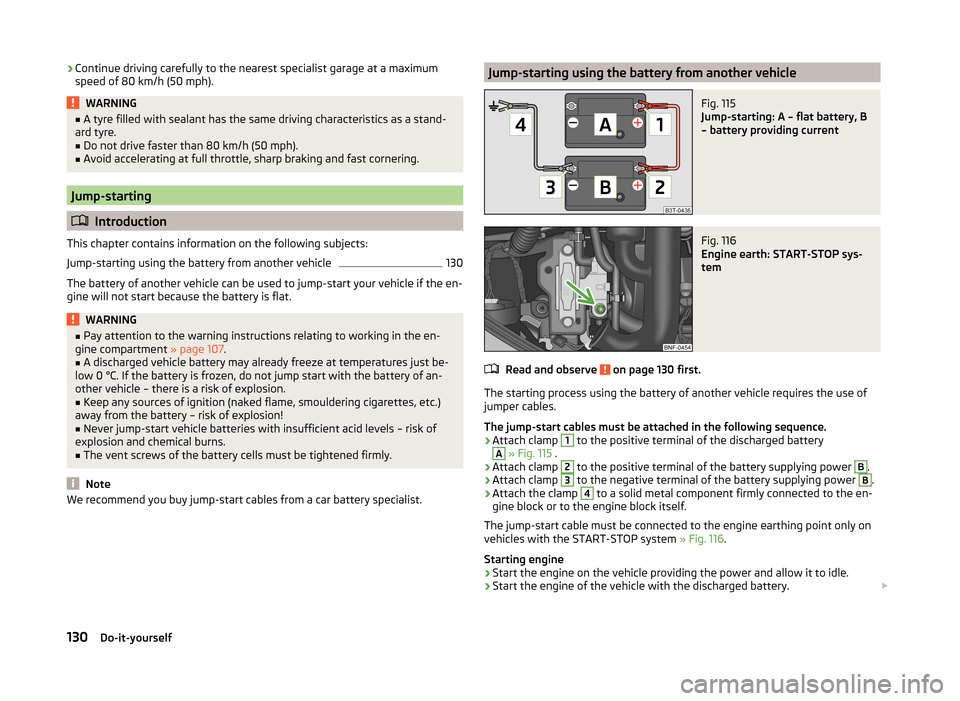
›Continue driving carefully to the nearest specialist garage at a maximum
speed of 80 km/h (50 mph).WARNING■ A tyre filled with sealant has the same driving characteristics as a stand-
ard tyre.■
Do not drive faster than 80 km/h (50 mph).
■
Avoid accelerating at full throttle, sharp braking and fast cornering.
Jump-starting
Introduction
This chapter contains information on the following subjects:
Jump-starting using the battery from another vehicle
130
The battery of another vehicle can be used to jump-start your vehicle if the en-
gine will not start because the battery is flat.
WARNING■ Pay attention to the warning instructions relating to working in the en-
gine compartment » page 107.■
A discharged vehicle battery may already freeze at temperatures just be-
low 0 °C. If the battery is frozen, do not jump start with the battery of an-
other vehicle – there is a risk of explosion.
■
Keep any sources of ignition (naked flame, smouldering cigarettes, etc.)
away from the battery – risk of explosion!
■
Never jump-start vehicle batteries with insufficient acid levels – risk of
explosion and chemical burns.
■
The vent screws of the battery cells must be tightened firmly.
Note
We recommend you buy jump-start cables from a car battery specialist.Jump-starting using the battery from another vehicleFig. 115
Jump-starting: A – flat battery, B
– battery providing current
Fig. 116
Engine earth: START-STOP sys-
tem
Read and observe on page 130 first.
The starting process using the battery of another vehicle requires the use of
jumper cables.
The jump-start cables must be attached in the following sequence.
›
Attach clamp
1
to the positive terminal of the discharged battery
A
» Fig. 115 .
›
Attach clamp
2
to the positive terminal of the battery supplying power
B
.
›
Attach clamp
3
to the negative terminal of the battery supplying power
B
.
›
Attach the clamp
4
to a solid metal component firmly connected to the en-
gine block or to the engine block itself.
The jump-start cable must be connected to the engine earthing point only on
vehicles with the START-STOP system » Fig. 116.
Starting engine
›
Start the engine on the vehicle providing the power and allow it to idle.
›
Start the engine of the vehicle with the discharged battery.
130Do-it-yourself
Page 134 of 164
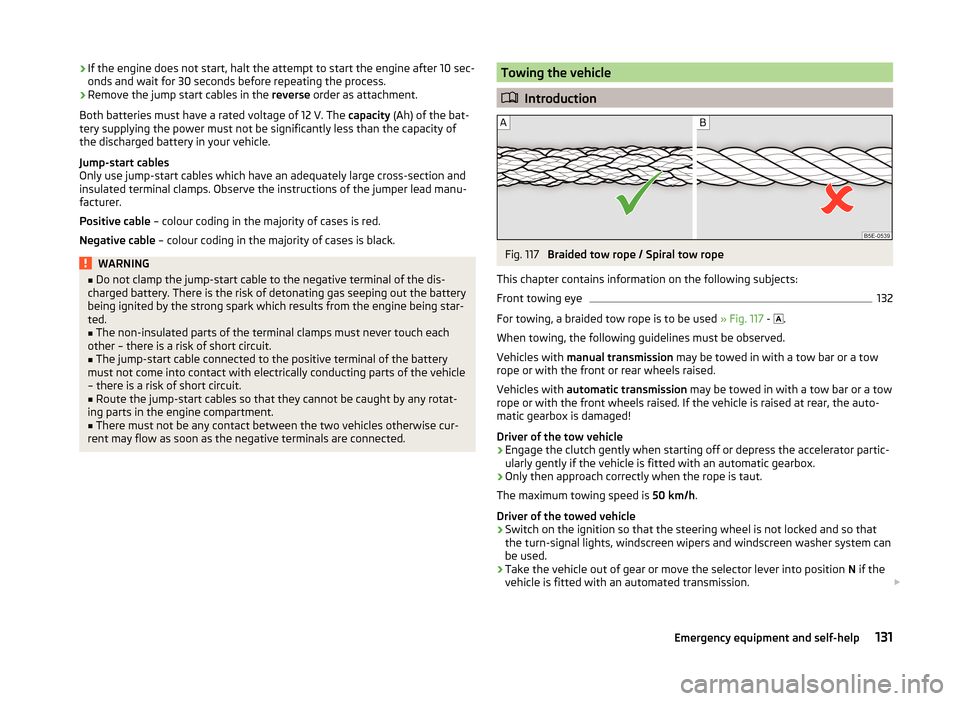
›If the engine does not start, halt the attempt to start the engine after 10 sec-
onds and wait for 30 seconds before repeating the process.›
Remove the jump start cables in the reverse order as attachment.
Both batteries must have a rated voltage of 12 V. The capacity (Ah) of the bat-
tery supplying the power must not be significantly less than the capacity of
the discharged battery in your vehicle.
Jump-start cables
Only use jump-start cables which have an adequately large cross-section and
insulated terminal clamps. Observe the instructions of the jumper lead manu-
facturer.
Positive cable – colour coding in the majority of cases is red.
Negative cable – colour coding in the majority of cases is black.
WARNING■
Do not clamp the jump-start cable to the negative terminal of the dis-
charged battery. There is the risk of detonating gas seeping out the battery
being ignited by the strong spark which results from the engine being star-
ted.■
The non-insulated parts of the terminal clamps must never touch each
other – there is a risk of short circuit.
■
The jump-start cable connected to the positive terminal of the battery
must not come into contact with electrically conducting parts of the vehicle
– there is a risk of short circuit.
■
Route the jump-start cables so that they cannot be caught by any rotat-
ing parts in the engine compartment.
■
There must not be any contact between the two vehicles otherwise cur-
rent may flow as soon as the negative terminals are connected.
Towing the vehicle
Introduction
Fig. 117
Braided tow rope / Spiral tow rope
This chapter contains information on the following subjects:
Front towing eye
132
For towing, a braided tow rope is to be used » Fig. 117 -
.
When towing, the following guidelines must be observed.
Vehicles with manual transmission may be towed in with a tow bar or a tow
rope or with the front or rear wheels raised.
Vehicles with automatic transmission may be towed in with a tow bar or a tow
rope or with the front wheels raised. If the vehicle is raised at rear, the auto-
matic gearbox is damaged!
Driver of the tow vehicle
›
Engage the clutch gently when starting off or depress the accelerator partic-
ularly gently if the vehicle is fitted with an automatic gearbox.
›
Only then approach correctly when the rope is taut.
The maximum towing speed is 50 km/h.
Driver of the towed vehicle
›
Switch on the ignition so that the steering wheel is not locked and so that
the turn-signal lights, windscreen wipers and windscreen washer system can
be used.
›
Take the vehicle out of gear or move the selector lever into position N if the
vehicle is fitted with an automated transmission.
131Emergency equipment and self-help
Page 135 of 164
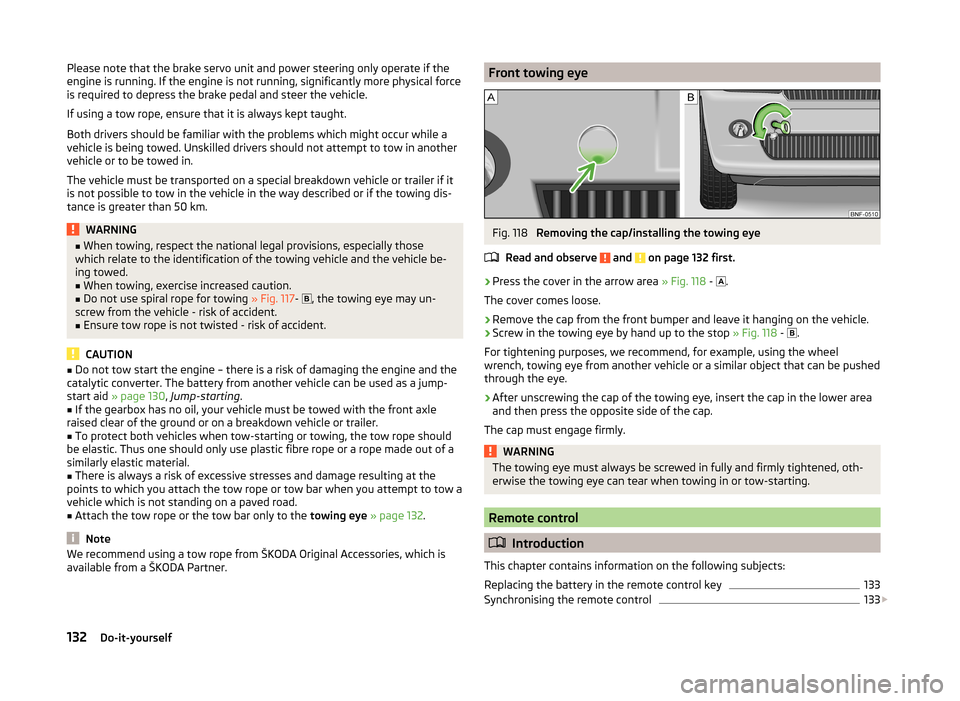
Please note that the brake servo unit and power steering only operate if the
engine is running. If the engine is not running, significantly more physical force
is required to depress the brake pedal and steer the vehicle.
If using a tow rope, ensure that it is always kept taught.
Both drivers should be familiar with the problems which might occur while a vehicle is being towed. Unskilled drivers should not attempt to tow in another
vehicle or to be towed in.
The vehicle must be transported on a special breakdown vehicle or trailer if it
is not possible to tow in the vehicle in the way described or if the towing dis-
tance is greater than 50 km.WARNING■ When towing, respect the national legal provisions, especially those
which relate to the identification of the towing vehicle and the vehicle be-
ing towed.■
When towing, exercise increased caution.
■
Do not use spiral rope for towing » Fig. 117-
, the towing eye may un-
screw from the vehicle - risk of accident.
■
Ensure tow rope is not twisted - risk of accident.
CAUTION
■ Do not tow start the engine – there is a risk of damaging the engine and the
catalytic converter. The battery from another vehicle can be used as a jump-
start aid » page 130 , Jump-starting .■
If the gearbox has no oil, your vehicle must be towed with the front axle
raised clear of the ground or on a breakdown vehicle or trailer.
■
To protect both vehicles when tow-starting or towing, the tow rope should
be elastic. Thus one should only use plastic fibre rope or a rope made out of a
similarly elastic material.
■
There is always a risk of excessive stresses and damage resulting at the
points to which you attach the tow rope or tow bar when you attempt to tow a
vehicle which is not standing on a paved road.
■
Attach the tow rope or the tow bar only to the towing eye » page 132 .
Note
We recommend using a tow rope from ŠKODA Original Accessories, which is
available from a ŠKODA Partner.Front towing eyeFig. 118
Removing the cap/installing the towing eye
Read and observe
and on page 132 first.
›
Press the cover in the arrow area » Fig. 118 -
.
The cover comes loose.
›
Remove the cap from the front bumper and leave it hanging on the vehicle.
›
Screw in the towing eye by hand up to the stop » Fig. 118 -
.
For tightening purposes, we recommend, for example, using the wheel
wrench, towing eye from another vehicle or a similar object that can be pushed
through the eye.
›
After unscrewing the cap of the towing eye, insert the cap in the lower area
and then press the opposite side of the cap.
The cap must engage firmly.
WARNINGThe towing eye must always be screwed in fully and firmly tightened, oth-
erwise the towing eye can tear when towing in or tow-starting.
Remote control
Introduction
This chapter contains information on the following subjects:
Replacing the battery in the remote control key
133
Synchronising the remote control
133
132Do-it-yourself
Page 153 of 164
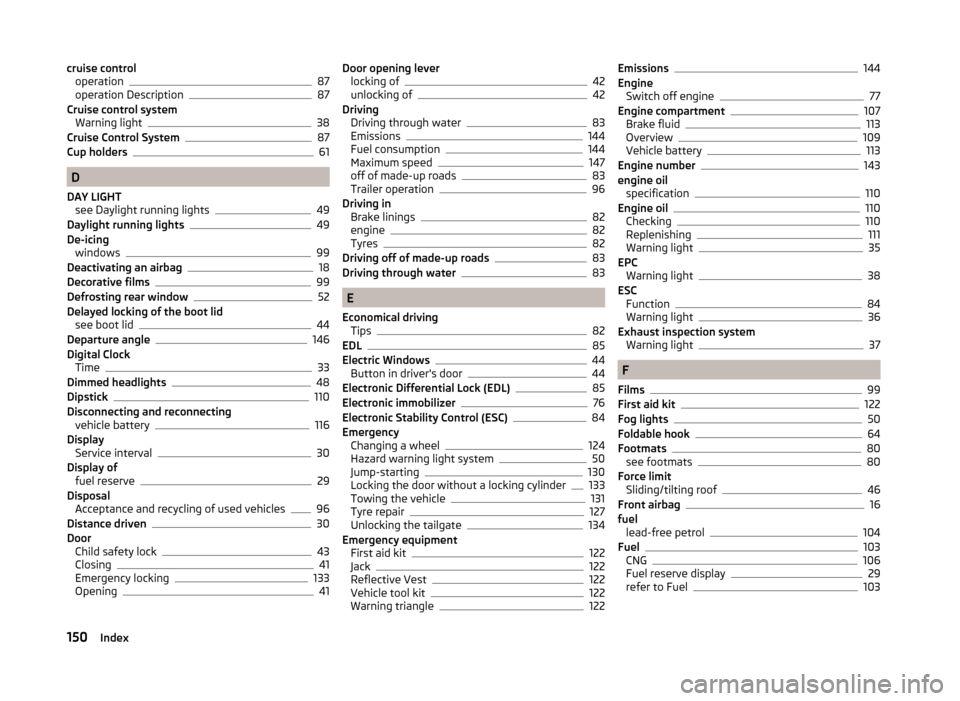
cruise controloperation87
operation Description87
Cruise control system Warning light
38
Cruise Control System87
Cup holders61
D
DAY LIGHT see Daylight running lights
49
Daylight running lights49
De-icing windows
99
Deactivating an airbag18
Decorative films99
Defrosting rear window52
Delayed locking of the boot lid see boot lid
44
Departure angle146
Digital Clock Time
33
Dimmed headlights48
Dipstick110
Disconnecting and reconnecting vehicle battery
116
Display Service interval
30
Display of fuel reserve
29
Disposal Acceptance and recycling of used vehicles
96
Distance driven30
Door Child safety lock
43
Closing41
Emergency locking133
Opening41
Door opening lever locking of42
unlocking of42
Driving Driving through water
83
Emissions144
Fuel consumption144
Maximum speed147
off of made-up roads83
Trailer operation96
Driving in Brake linings
82
engine82
Tyres82
Driving off of made-up roads83
Driving through water83
E
Economical driving Tips
82
EDL85
Electric Windows44
Button in driver's door44
Electronic Differential Lock (EDL)85
Electronic immobilizer76
Electronic Stability Control (ESC)84
Emergency Changing a wheel
124
Hazard warning light system50
Jump-starting130
Locking the door without a locking cylinder133
Towing the vehicle131
Tyre repair127
Unlocking the tailgate134
Emergency equipment First aid kit
122
Jack122
Reflective Vest122
Vehicle tool kit122
Warning triangle122
Emissions144
Engine Switch off engine
77
Engine compartment107
Brake fluid113
Overview109
Vehicle battery113
Engine number143
engine oil specification
110
Engine oil110
Checking110
Replenishing111
Warning light35
EPC Warning light
38
ESC Function
84
Warning light36
Exhaust inspection system Warning light
37
F
Films
99
First aid kit122
Fog lights50
Foldable hook64
Footmats80
see footmats80
Force limit Sliding/tilting roof
46
Front airbag16
fuel lead-free petrol
104
Fuel103
CNG106
Fuel reserve display29
refer to Fuel103
150Index
Page 154 of 164
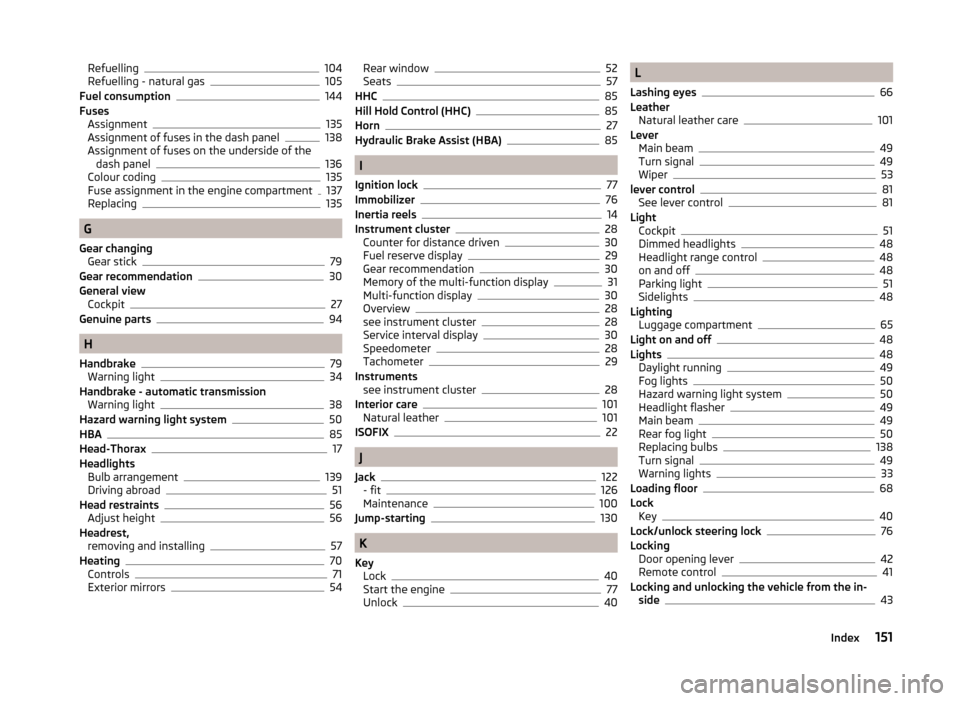
Refuelling104
Refuelling - natural gas105
Fuel consumption144
Fuses Assignment
135
Assignment of fuses in the dash panel138
Assignment of fuses on the underside of the dash panel
136
Colour coding135
Fuse assignment in the engine compartment137
Replacing135
G
Gear changing Gear stick
79
Gear recommendation30
General view Cockpit
27
Genuine parts94
H
Handbrake
79
Warning light34
Handbrake - automatic transmission Warning light
38
Hazard warning light system50
HBA85
Head-Thorax17
Headlights Bulb arrangement
139
Driving abroad51
Head restraints56
Adjust height56
Headrest, removing and installing
57
Heating70
Controls71
Exterior mirrors54
Rear window52
Seats57
HHC85
Hill Hold Control (HHC)85
Horn27
Hydraulic Brake Assist (HBA)85
I
Ignition lock
77
Immobilizer76
Inertia reels14
Instrument cluster28
Counter for distance driven30
Fuel reserve display29
Gear recommendation30
Memory of the multi-function display31
Multi-function display30
Overview28
see instrument cluster28
Service interval display30
Speedometer28
Tachometer29
Instruments see instrument cluster
28
Interior care101
Natural leather101
ISOFIX22
J
Jack
122
- fit126
Maintenance100
Jump-starting130
K
Key Lock
40
Start the engine77
Unlock40
L
Lashing eyes
66
Leather Natural leather care
101
Lever Main beam
49
Turn signal49
Wiper53
lever control81
See lever control81
Light Cockpit
51
Dimmed headlights48
Headlight range control48
on and off48
Parking light51
Sidelights48
Lighting Luggage compartment
65
Light on and off48
Lights48
Daylight running49
Fog lights50
Hazard warning light system50
Headlight flasher49
Main beam49
Rear fog light50
Replacing bulbs138
Turn signal49
Warning lights33
Loading floor68
Lock Key
40
Lock/unlock steering lock76
Locking Door opening lever
42
Remote control41
Locking and unlocking the vehicle from the in- side
43
151Index
Page 156 of 164

Puncture repair kit127
R
Radiator fan
109
Radio4
Raising the vehicle126
Rear-view mirror Exterior mirrors
54
Rear fog light50
Warning light37
Rear mirror54
Interior mirror54
Rear window heating52
Rear windows Closing
45
Opening45
Recirculation72
Refuelling104
Fuel104
Fuel - natural gas105
Regulation Lighting range
48
Remote control Locking
41
Replacing the battery133
Synchronisation process133
Unlocking41
Remote control key Replacing the battery
133
Repairs and technical alterations93
Replace vehicle battery
116
Replace vehicle battery
116
Replacing Bulb for daytime running lights and parkinglights
139
Bulb for the fog light140
Bulb for the licence plate light141
Bulb for the side turn signal lights140
Bulbs138
Fuses135
Fuses in the dash panel138
Fuses in the engine compartment137
window wiper blade135
windscreen wiper blades134
Replenishing Coolant
112
Engine oil111
Windscreen washer fluid109
Roof Load
69
Roof rack68
mounting points69
Roof load69
Rubber seals98
Running in and economical driving82
S
SAFE See Safe securing system
42
SAFELOCK See Safe securing system
42
Safe securing system42
Safety8
Child safety19
Child safety seats19
Correct seated position9
Head restraints56
ISOFIX22
TOP TETHER23
Safety belt Warning symbol
38
Save electrical energy82
Save fuel82
Seals Vehicle care
98
Seat Adjusting
56
Seat belts11
Belt tensioners14
fastening and unfastening13
Inertia reels14
The physical principle of a frontal collision13
Warning light34
Seat features57
Seats Folding front passenger seat
58
Head restraints56
Heating57
Seat backrests59
Seats and head restraint55
Service94
Service display30
Setting33
seats and head restraints55
Setting the33
Shift Gear recommendation
30
Information on the gear changed30
Side airbag17
Sidelights48
Sliding/tilting roof Closing
46
Opening and tilting46
Operation46
Snow chains121
spare123
spare wheel123
instructions123
Spare wheel Change
123
Speedometer28
Speed symbol See Wheels
120
Spoiler95
Staring engine Jump-starting
130
153Index
Page 157 of 164
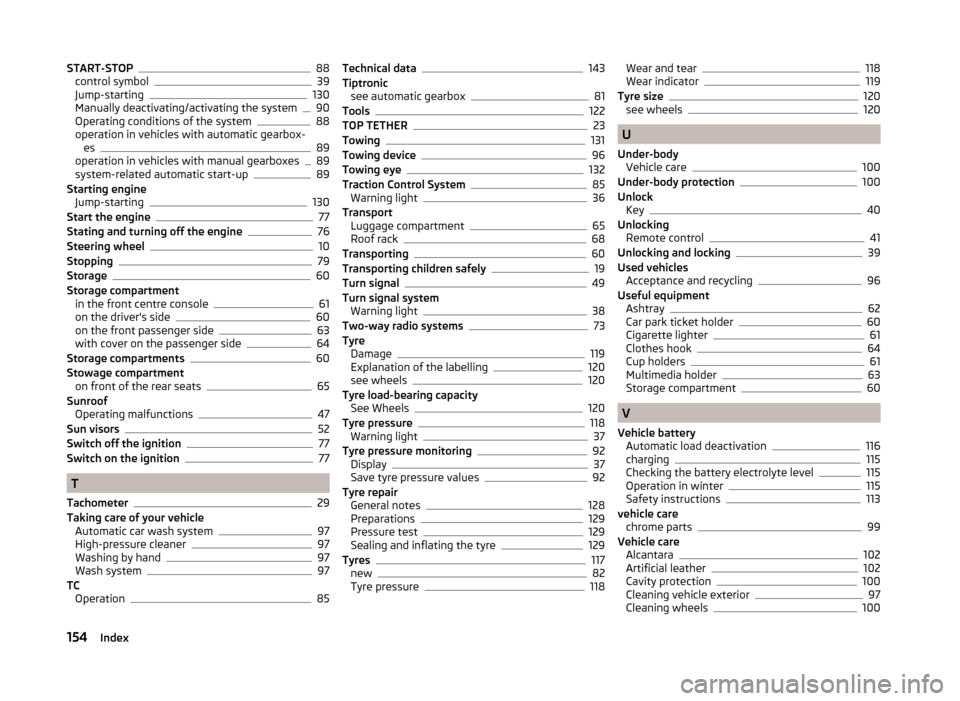
START-STOP88
control symbol39
Jump-starting130
Manually deactivating/activating the system90
Operating conditions of the system88
operation in vehicles with automatic gearbox- es
89
operation in vehicles with manual gearboxes89
system-related automatic start-up89
Starting engine Jump-starting
130
Start the engine77
Stating and turning off the engine76
Steering wheel10
Stopping79
Storage60
Storage compartment in the front centre console
61
on the driver's side60
on the front passenger side63
with cover on the passenger side64
Storage compartments60
Stowage compartment on front of the rear seats
65
Sunroof Operating malfunctions
47
Sun visors52
Switch off the ignition77
Switch on the ignition77
T
Tachometer
29
Taking care of your vehicle Automatic car wash system
97
High-pressure cleaner97
Washing by hand97
Wash system97
TC Operation
85
Technical data143
Tiptronic see automatic gearbox
81
Tools122
TOP TETHER23
Towing131
Towing device96
Towing eye132
Traction Control System85
Warning light36
Transport Luggage compartment
65
Roof rack68
Transporting60
Transporting children safely19
Turn signal49
Turn signal system Warning light
38
Two-way radio systems73
Tyre Damage
119
Explanation of the labelling120
see wheels120
Tyre load-bearing capacity See Wheels
120
Tyre pressure118
Warning light37
Tyre pressure monitoring92
Display37
Save tyre pressure values92
Tyre repair General notes
128
Preparations129
Pressure test129
Sealing and inflating the tyre129
Tyres117
new82
Tyre pressure118
Wear and tear118
Wear indicator119
Tyre size120
see wheels120
U
Under-body Vehicle care
100
Under-body protection100
Unlock Key
40
Unlocking Remote control
41
Unlocking and locking39
Used vehicles Acceptance and recycling
96
Useful equipment Ashtray
62
Car park ticket holder60
Cigarette lighter61
Clothes hook64
Cup holders61
Multimedia holder63
Storage compartment60
V
Vehicle battery Automatic load deactivation
116
charging115
Checking the battery electrolyte level115
Operation in winter115
Safety instructions113
vehicle care chrome parts
99
Vehicle care Alcantara
102
Artificial leather102
Cavity protection100
Cleaning vehicle exterior97
Cleaning wheels100
154Index